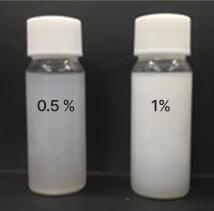INDUSTRIES APPLICATIONS
Nano Emulsions
Pharmaceutical Industries / Tocopheryl acetate
Manufacturing of non-surfactant-based ophthalmic emulsion (D-Оұ-Tocopheryl Acetate, nanoemulsion)
Many medications have limited clinical application due to their low pharmacokinetic (PK) and pharmacodynamic (PD) properties, low bioavailability, and toxicity. To overcome these drawbacks, various forms of nanomedicines are being researched. The market size for nanomedicines was estimated to be $27 billion in 2018 and is predicted to grow to $49.2 billion by 2025, with a compound annual growth rate of 7.3%.
Nanomedicines can be categorized into three different forms: (a) nanoparticles that physically encapsulate drugs, (b) immunoconjugates that chemically attach drugs to delivery systems, and (c) nano-emulsions, which act as drug delivery systems (DDS) by forming colloidal dispersions of oil and water.
Currently, nano-emulsion is being researched primarily by global pharmaceutical companies such as AstraZeneca, Novartis, Hoffmann-La Roche, AbbVie, Biofrontera AG, Ocugen Inc, and others. These companies constitute around 8% of the market share of nanomedicines.
- 'Nano Pharmaceuticals Industry Status' Bio Economy Brief May 2020, Issue 82: Korea Bio-Economy Research Center.
Advantages of using Focused Ultra Sonication Technology (FUST) when manufacturing nanomedicines:
- Improved Drug Load compared to conventional emulsions.
- Enhanced stability of pharmaceutical formulations (emulsion phase separation prevention).
- Smaller drug particle size, minimizing losses during processes such as filtration and sterilization.
- Organic solvents and surfactants not needed, which reduces toxicity.
Manufacturing of non-surfactant- based D-Оұ- Tocopheryl Acetate nanoemulsion:

- Ingredients : D-Оұ-Tocopheryl Acetate (0.5~1%)
- Solvent : Purified water and other non-surfactant additives
- Formulation : Non-surfactant-based ophthalmic emulsion
- Manufacturing method : Focused Ultra Sonication Technology (Nano-Emulsification)
Evaluation of dispersion uniformity and formulation stability:
- Measurement equipment : CytoViva (Enhanced Dark field Microscope)
Nikon Eclipse 50i (Polarizing Filter / Olympus, U-PO) - Result : Non-uniform dispersion
Observation of commercially available ophthalmic
formulation under a microscope.
- Measurement equipment : CytoViva (Enhanced Dark field Microscope)
Nikon Eclipse 50i (Polarizing Filter / Olympus, U-PO) - Result : Uniform dispersion / Maintained formulation stability
Non-surfactant-based Tocopheryl Acetate emulsion using (FUST) Focused ultrasonication technology.

